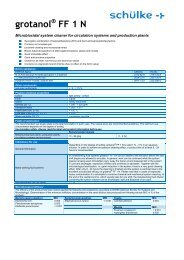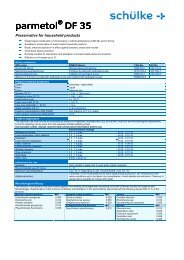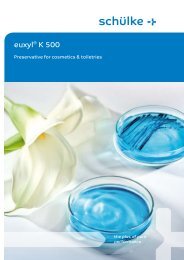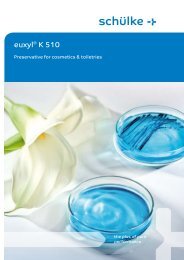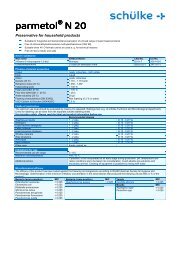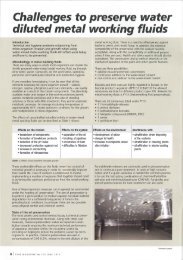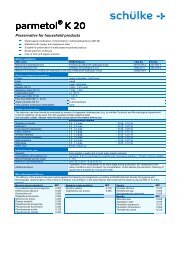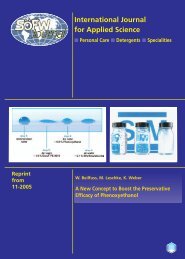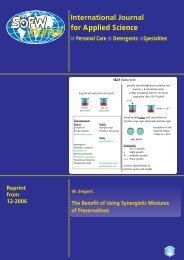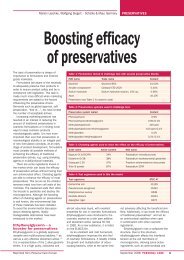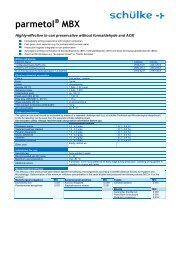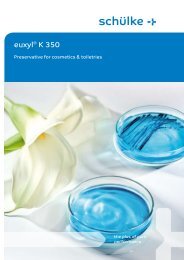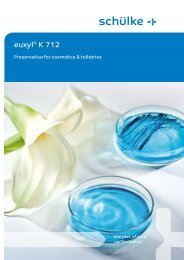ISO 11930 â A Comparison to other Methods to ... - ResearchGate
ISO 11930 â A Comparison to other Methods to ... - ResearchGate
ISO 11930 â A Comparison to other Methods to ... - ResearchGate
Create successful ePaper yourself
Turn your PDF publications into a flip-book with our unique Google optimized e-Paper software.
COSMETICS<br />
PRESERVATION<br />
W. Siegert*<br />
<strong>ISO</strong> <strong>11930</strong> – A <strong>Comparison</strong> <strong>to</strong> <strong>other</strong> <strong>Methods</strong><br />
<strong>to</strong> Evaluate the Efficacy of Antimicrobial<br />
Preservation<br />
■ Legal Regulations<br />
Only in the SCCS notes of guidance, the<br />
demands for challenge testing are specified.<br />
In paragraph 4-4 »Guidelines on Microbiological<br />
of the Finished Cosmetic<br />
Product« in the 7 th revision (December<br />
2010) (7) of the SCCS publication »Notes<br />
of Guidance for the Testing of Cosmetic<br />
Ingredients and their Safety Evaluation«<br />
is an obligation for carrying out a preservation<br />
test with all cosmetic products<br />
which could be contaminated under<br />
normal s<strong>to</strong>rage and usage conditions or<br />
if an infection risk for the consumer exists.<br />
The use of Pseudomonas aeruginosa,<br />
Staphylococcus aureus and Candida albicans<br />
from official collection strains<br />
from any state within the EU is obliga<strong>to</strong>ry.<br />
In addition, the use of specific germs,<br />
which are known <strong>to</strong> lead <strong>to</strong> spoilage of<br />
cosmetic products, is recommended.<br />
■ <strong>ISO</strong> <strong>11930</strong><br />
Compared <strong>to</strong> <strong>other</strong> methods <strong>ISO</strong> <strong>11930</strong> is<br />
an overall standard <strong>to</strong> evaluate the antimicrobial<br />
stabilisation of a cosmetic product.<br />
With the decision diagram in Annex<br />
A also formulations intrinsically hostile<br />
<strong>to</strong> microbial growth, specific manufacturing<br />
conditions, packaging and/or conditions<br />
for use and the reference <strong>to</strong> <strong>ISO</strong><br />
29261 (Guidelines for the risk assessment<br />
and identification of microbiologically<br />
low-risk products) (7) are covered.<br />
Nevertheless, the preservative efficacy<br />
test described in <strong>ISO</strong> <strong>11930</strong> is primarily<br />
designed for water-soluble or water-miscible<br />
products.<br />
This publication compares the following<br />
test methods:<br />
• <strong>ISO</strong> <strong>11930</strong> »Evaluation of the antimicrobial<br />
protection of a cosmetic product«<br />
(1)<br />
• SCCS »Notes of Guidance for the Testing<br />
of Cosmetic Ingredients and their<br />
Safety Evaluation« (7)<br />
• schülke KoKo test »Determination of<br />
the Preserving Effect of Chemical<br />
Preservatives in Cosmetic Formulations«<br />
Introduction<br />
• Ph. Eur. 7 - 5.1.3 »Efficacy of Antimicrobial<br />
Preservation«(3)<br />
• USP 35 »Antimicrobial Effectiveness<br />
Testing« (4)<br />
• ASEAN ACM MAL 08 »Preservative Efficacy<br />
Test for Cosmetic Product« (5)<br />
• CTFA M-3 »A Method for Preservation<br />
Testing of Water-Miscible Personal<br />
Care Products« (6)<br />
• CTFA M-4 »Method for Preservation<br />
Testing of Eye Area Cosmetics« (6).<br />
The first edition of <strong>ISO</strong> <strong>11930</strong> (1) was published in April 2012 under the<br />
title »Cosmetics – Microbiology – Evaluation of the antimicrobial protection<br />
of a cosmetic product«. This test can be used <strong>to</strong> evaluate the<br />
preservation of a cosmetic formulation.<br />
While the regulation on cosmetic products (EC 1223/2009) (2) requires<br />
that the cosmetic product safety report demonstrates the results of preservation<br />
challenge test <strong>to</strong> prove the microbiological stability, it does not<br />
specify the test procedure for the challenge test. In addition <strong>to</strong> <strong>ISO</strong> <strong>11930</strong><br />
tests from the EU (3) and US pharmacopoeia (4), the ASEAN preservative<br />
efficacy test (5), the test from the CTFA Microbiology Guidelines (6) as well<br />
as several in-house test pro<strong>to</strong>cols have been established for many years.<br />
This paper includes a comparison of the different methods and comparative<br />
test results for <strong>ISO</strong> <strong>11930</strong>, Ph. Eur. 7 and the schülke KoKo Test.<br />
44 SOFW-Journal | 138 | 7-2012




